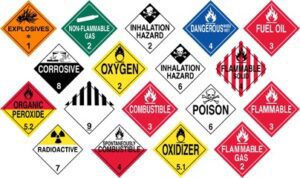A Brief Guide To Hazardous Waste Container Labeling & Marking
April 24, 2024
This blog entry discusses both EPA and DOT rules for labeling & marking hazardous waste containers. Q&As include:
- What are the hazmat waste labeling requirements for the EPA and DOT?
- Are there specified EPA and DOT formats for labeling & marking hazmat?
- What’s the general guidance for EPA labeling hazmat containers?
- What’s the general guidance for DOT labeling & marking hazmat containers?
- How does “bulk packaging” differ from “non-bulk packaging?”
- What’s the difference between “labeling” and “marking” hazmat?
- Where can you get comprehensive guidance about hazmat labeling and marking?
What are the hazmat waste labeling requirements for the EPA and DOT?
This isn’t an easy question. No list of do’s & don’ts can be up-to-the-minute, as the DOT and EPA rules for labeling & marking hazardous waste tend to be moving targets. So, it would be prudent to get the latest expert advice before placing any artwork on your barrels of hazmat.
Are there specified EPA and DOT formats for labeling & marking hazmat?
There’s no prescribed format, but there are DOT requirements and EPA requirements that somewhat overlap—and all of which you must be careful to address. That said, we’ve provided some must-do’s specific to each agency (see Q.3 and Q.4). But you should get expert advice about the specific kind(s) and amount(s) of hazmat you intend to store and transport.
What’s the general guidance for EPA labeling hazmat containers?
To keep the EPA happy, a container used for hazmat onsite storage must be marked with the words “Hazardous Waste.” It must also exhibit the starting date for its accumulation along with information about its contents. E.g., toxic, reactive, ignitable, or corrosive (see source).
If you’re reusing a container, remember to remove old labels. And whether new or used, you need to place a label on a container the very first moment that any hazmat is placed inside it. Fail to do that and you’re out of compliance—and your righteous protests (that you would have done so at your very first convenience) will not sway a cranky EPA inspector.
BTW, to avoid visual confusion, all your colleagues, team members, associates, workers, employees, and onsite relatives should use the same labeling method (e.g., handwritten vs. printed forms). And each should have a clear understanding of what the markings signify—regardless of whether he or she directly tends to your hazardous waste disposal efforts.
What’s the general guidance for DOT labeling & marking hazmat containers?
No kidding: DOT requirements are more complicated than their EPA counterparts.
To fully appreciate them, you need to consider the differences between & among “bulk” vs. “non-bulk” packaging and “marking” vs. “labeling” (see Q.5 and Q.6, respectively).
Meanwhile…
Per the DOT, not only must the container be clearly labeled as hazmat, it must also prominently display this notice:
HAZARDOUS WASTE—Federal Law Prohibits Improper Disposal. If found, contact the nearest police or public safety authority or the U.S. Environmental Protection Agency.
Additionally, the container must clearly show your company’s name, EPA identification number and manifest tracking number; and there might be additional requirements for bulk-packaging containers (see Q.5).
Labeling must be durable, clearly visible, and written in English. It must be displayed on a contrasting color background and not be obscured by other labels, attachments, or advertising.
How does “bulk packaging” differ from “non-bulk packaging?”
In this instance, size definitely matters.
DOT labeling & marking requirements differ depending upon the amount of hazardous waste you generate. In this regard, the EPA specifies two categories: Bulk packaging (see 172.302) and Non-bulk packaging (see 172.301).
Loosely speaking, non-bulk packaging dictates a maximum capacity of 119 gal. for a liquid waste (450 L); a maximum of 882 lbs. for a solid waste (400 kg); or a water capacity of 1000 lbs. for a gaseous waste (454 kg). Thereby, bulk packaging is anything that exceeds these quantities (see source).
What’s the difference between “labeling” and “marking” hazmat?
Marking (as opposed to “labeling”) is a DOT distinction. For their purposes, “labeling” is a very specific thing that’s applicable only to bulk packaging (see Q.5). “Labels” are always diamond-shape; and their size must adhere to international standards, measuring at least 4″ x 4″ (100 mm) on each side, square-on-point. Everything else (applicable to non-bulk packaging) is merely “marking.”
The DOT uses nine categorical hazmat labels. (See colorful facsimiles below.)
- Explosives
- Compressed gas
- Flammable & combustible liquid
- Flammable & reactive solids
- Oxidizers & organic peroxides
- Poisonous materials & infectious substances
- Radioactive materials
- Corrosives
- Miscellaneous

Some typical “square-on-point” hazmat labels.
Where can you get comprehensive guidance about hazmat labeling and marking?
As they tend to come from both the EPA and DOT at haphazard intervals, regulations about labeling & marking are plentiful, evolving, and challenging to track. Managing their many aspects can divert your company’s human and budgetary resources from its core mission; and whether by unawareness or misunderstanding, noncompliance can subject you to pecuniary and even criminal consequences.
Don’t take chances. Get honest expert advice from a renowned provider of hazardous waste management services.
We’ve earned our reputation by anticipating the needs of our clients so that waste management doesn’t become a major distraction from their corporate mission.
For more information, contact us today. Or call 888-681-8923.
And thank you for reading our blog!

